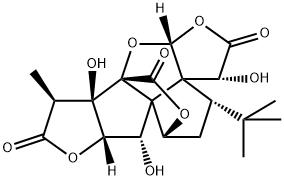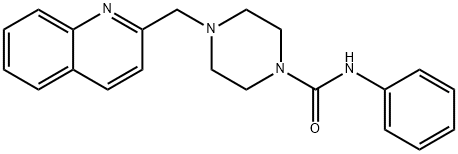2-BROMOHEXADECANOIC ACID
Synonym(s):2-Bromopalmitic acid
- CAS NO.:18263-25-7
- Empirical Formula: C16H31BrO2
- Molecular Weight: 335.32
- MDL number: MFCD00004215
- EINECS: 242-137-0
- SAFETY DATA SHEET (SDS)
- Update Date: 2025-12-26 08:49:36

What is 2-BROMOHEXADECANOIC ACID?
Description
2-Bromopalmitic acid (18263-25-7) inhibits?protein S-palmitoylation.1 Blocks palmitic acid-induced increase in cAMP levels in human primary melanocytes expressing the melanocortin-1 receptor which undergoes an essential palmitoylation as a prerequisite for receptor signaling.2
Chemical properties
WHITE CRYSTALLINE POWDER
The Uses of 2-BROMOHEXADECANOIC ACID
2-Bromopalmitic Acid is used in preparation of substituted purines and their analogs for inhibiting the expression of a pattern recognition receptor.
What are the applications of Application
2-Bromohexadecanoic acid is a PPARδ agonist
Definition
ChEBI: A bromo fatty acid that is hexadecanoic (palmitic) acid carrying a single bromo substituent at position 2.
General Description
PPARδ (peroxisome proliferator-activated receptor, delta isoform) acts as a transcription factor for gene expression as well as playing a role in lipid metabolism regulation; activity of this receptor is ligand-regulated. 2-Bromohexadecanoic acid is a metabolically stable analoge of the fatty acid palmitic acid that has been shown to be a natural ligand for the PPARδ receptor. 2-Bromohexadecanoic acid has also been used in studies of fatty acid oxidation, palmitoylation, and glucose uptake.
Biochem/physiol Actions
2-Bromohexadecanoic acid is a PPARδ agonist. It has also been shown to inhibit fatty acid oxidation, inhibit DHHC-mediated palmitoylation, and promote glucose uptake in rat cardiac cells and the insulin-sensitive murine fibroblast line A31-IS.
Purification Methods
Recrystallise the acid from pet ether (b 60-80o, charcoal) and finally from EtOH. The ethyl ester has b 177-178o/2mm, d28 1.0484, n D 1.4560. [IR: Sweet & Estes J Org Chem 21 1426 1956, Beilstein 2 IV 1184.]
References
1) Tsukamoto et al. (2013), Role of S-palmitoylation on IFITM5 for the interaction with FKBP11 in osteoblast cells; PLoS One, 8(9) e75831 2) Chen et al. (2017), Palmitoylation-dependent activation of MC1R prevents melanomagenesis; Nature, 549 399
Properties of 2-BROMOHEXADECANOIC ACID
| Melting point: | 52-54 °C |
| Boiling point: | 403.4±18.0 °C(Predicted) |
| Density | 1.1985 (rough estimate) |
| refractive index | 1.4650 (estimate) |
| Flash point: | 113 °C |
| storage temp. | RT |
| solubility | methanol: soluble1g/10 mL, clear, colorless |
| form | solid |
| pka | 2.97±0.21(Predicted) |
| color | White |
| BRN | 1726517 |
| Stability: | Stable for 1 year from date of purchase as supplied. Solutions in DMSO or ethanol may be stored at -20°C for up to 2 months. |
| CAS DataBase Reference | 18263-25-7(CAS DataBase Reference) |
| EPA Substance Registry System | Hexadecanoic acid, 2-bromo- (18263-25-7) |
Safety information for 2-BROMOHEXADECANOIC ACID
| Signal word | Warning |
| Pictogram(s) |
 Exclamation Mark Irritant GHS07 |
| GHS Hazard Statements |
H315:Skin corrosion/irritation H319:Serious eye damage/eye irritation H335:Specific target organ toxicity, single exposure;Respiratory tract irritation |
| Precautionary Statement Codes |
P261:Avoid breathing dust/fume/gas/mist/vapours/spray. P305+P351+P338:IF IN EYES: Rinse cautiously with water for several minutes. Remove contact lenses, if present and easy to do. Continuerinsing. |
Computed Descriptors for 2-BROMOHEXADECANOIC ACID
2-BROMOHEXADECANOIC ACID manufacturer
JSK Chemicals
New Products
4,4-Difluoropiperidine hydrochloride tert-butyl 9-methoxy-3-azaspiro[5.5]undecane-3-carboxylate Indole Methyl Resin N-Isopropylurea N,N-Dicyclohexylcarbodiimide(DCC) MELDRUMS ACID 5-METHYLISOXAZOLE-4-CARBOXYLIC ACID Magnessium Bis glycinate Zinc ascorbate 1-bromo-2-butyne 2-acetamidophenol 9(10H)-anthracenone Erythrosin B, 4-Piperidinopiperidine 2-((4-morpholinophenylamino) (methylthio) methylene) malononitrile 2,4-dihydroxybenzaldehyde 3-(4-morpholinophenylamino)-5-amino-1H-pyrazole-4-carbonitrile Methyl 2-methylquinoline-6-carboxylate 2,6-dichloro-4-nitropyridine 4-Bromo-2-chlorobenzonitrile 2-(benzylamino)acetic acid hydrochloride 4-(tert-Butoxycarbonylamino)but- 2-ynoic acid 3,4-dihydro-2H-benzo[b][1,4]dioxepine 1-Phenyl-1-cycloprppanecarboxylicacidRelated products of tetrahydrofuran








You may like
-
 2-Bromohexadecanoic Acid 99%View Details
2-Bromohexadecanoic Acid 99%View Details
18263-25-7 -
 2-Bromohexadecanoic Acid 99%View Details
2-Bromohexadecanoic Acid 99%View Details
18263-25-7 -
 2-Bromohexadecanoic acid, 98% 99%View Details
2-Bromohexadecanoic acid, 98% 99%View Details
18263-25-7 -
 2-Bromohexadecanoic acid CAS 18263-25-7View Details
2-Bromohexadecanoic acid CAS 18263-25-7View Details
18263-25-7 -
 2-Bromohexadecanoic acid CAS 18263-25-7View Details
2-Bromohexadecanoic acid CAS 18263-25-7View Details
18263-25-7 -
 20677-73-0 (2,2-diethoxyethyl)methylamine 98%View Details
20677-73-0 (2,2-diethoxyethyl)methylamine 98%View Details
20677-73-0 -
 3-(4-(hydroxyamino)-1-oxoisoindolin-2-yl)piperidine-2,6-dione 98%View Details
3-(4-(hydroxyamino)-1-oxoisoindolin-2-yl)piperidine-2,6-dione 98%View Details -
 57381-49-4 2-bromo-4-chlorobenzonitrile 98%View Details
57381-49-4 2-bromo-4-chlorobenzonitrile 98%View Details
57381-49-4
